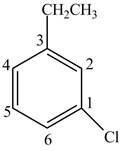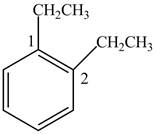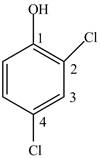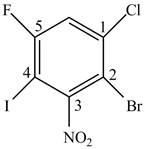
(a)
Interpretation:
The name of the benzene derivative compound is to be stated.
Concept introduction:
IUPAC stands for International Union of Pure and Applied Chemistry. The IUPAC gave certain rules which are used worldwide to name the organic compounds. Due to IUPAC naming, each compound has a unique name which is different from their common name.
In aryl compounds, the substituents are indicated by the numbers and the aromatic ring is named as benzene.
Answer to Problem 16.1P
The IUPAC name of the aromatic compound is
Explanation of Solution
(1) The six-membered aromatic ring is named as benzene.
(2) If a
(3) The substituents on the benzene ring are indicated by the numbers and are named in alphabetical order.
(4) The lowest locant rule is used. The substituent which comes first in the alphabetical order is numbered one and then the numbering is done in the direction such that the other substituent gets the maximum lower numerical value.
(5) If a functional group is attached on the benzene ring, then that carbon is numbered one.
In Figure 1, the benzene ring contains chloro and the ethyl group. The numbering starts from the carbon atom containing chloro group since it comes first in the alphabetical series and the numbering is done according to lowest locant rule.

Figure 1
The rule of naming an aromatic compound according to IUPAC is
Therefore, the IUPAC name of the aromatic compound is
The IUPAC name of the aromatic compound is
(b)
Interpretation:
The name of the benzene derivative compound is to be stated.
Concept introduction:
IUPAC stands for International Union of Pure and Applied Chemistry. The IUPAC gave certain rules which are used worldwide to name the organic compounds. Due to IUPAC naming, each compound has a unique name which is different from their common name.
In aryl compounds, the substituents are indicated by the numbers and the aromatic ring is named as benzene.
Answer to Problem 16.1P
The IUPAC name of the aromatic compound is
Explanation of Solution
Aromatic compounds are those compounds which contains at least one aromatic ring. The naming of aromatic compounds uses the same rules as aliphatic compounds.
(1) The six-membered aromatic ring is named as benzene.
(2) If a functional group is present on the benzene ring, then the benzene is named as phenyl.
(3) The substituents on the benzene ring are indicated by the numbers and are named in alphabetical order.
(4) The lowest locant rule is used. The substituent which comes first in the alphabetical order is numbered one and then the numbering is done in the direction such that the other substituent gets the maximum lower numerical value.
(5) If a functional group is attached on the benzene ring, then that carbon is numbered one.
In Figure 2, the benzene ring contains two ethyl groups. So, numbering can be done from any carbon containing ethyl group using lowest locant rule.

Figure 2
The rule of naming an aromatic compound according to IUPAC is
Therefore, the IUPAC name of the aromatic compound is
The IUPAC name of the aromatic compound is
(c)
Interpretation:
The name of the benzene derivative compound is to be stated.
Concept introduction:
IUPAC stands for International Union of Pure and Applied Chemistry. The IUPAC gave certain rules which are used worldwide to name the organic compounds. Due to IUPAC naming, each compound has a unique name which is different from their common name.
In aryl compounds, the substituents are indicated by the numbers and the aromatic ring is named as benzene.
Answer to Problem 16.1P
The IUPAC name of the aromatic compound is
Explanation of Solution
Aromatic compounds are those compounds which contains at least one aromatic ring. The naming of aromatic compounds uses the same rules as aliphatic compounds.
(1) The six-membered aromatic ring is named as benzene.
(2) If a functional group is present on the benzene ring, then the benzene is named as phenyl.
(3) The substituents on the benzene ring are indicated by the numbers and are named in alphabetical order.
(4) The lowest locant rule is used. The substituent which comes first in the alphabetical order is numbered one and then the numbering is done in the direction such that the other substituent gets the maximum lower numerical value.
(5) If a functional group is attached on the benzene ring, then that carbon is numbered one.
In Figure 3, the benzene ring contains nitro and the vinyl group. The numbering starts from the carbon atom containing nitrro group since it comes first in the alphabetical series and the numbering is done according to lowest locant rule.

Figure 3
The rule of naming an aromatic compound according to IUPAC is
Therefore, the IUPAC name of the aromatic compound is
The IUPAC name of the aromatic compound is
(d)
Interpretation:
The name of the benzene derivative compound is to be stated.
Concept introduction:
IUPAC stands for International Union of Pure and Applied Chemistry. The IUPAC gave certain rules which are used worldwide to name the organic compounds. Due to IUPAC naming, each compound has a unique name which is different from their common name.
In aryl compounds, the substituents are indicated by the numbers and the aromatic ring is named as benzene.
Answer to Problem 16.1P
The IUPAC name of the aromatic compound is
Explanation of Solution
Aromatic compounds are those compounds which contains at least one aromatic ring. The naming of aromatic compounds uses the same rules as aliphatic compounds.
(1) The six-membered aromatic ring is named as benzene.
(2) If a functional group is present on the benzene ring, then the benzene is named as phenyl.
(3) The substituents on the benzene ring are indicated by the numbers and are named in alphabetical order.
(4) The lowest locant rule is used. The substituent which comes first in the alphabetical order is numbered one and then the numbering is done in the direction such that the other substituent gets the maximum lower numerical value.
(5) If a functional group is attached on the benzene ring, then that carbon is numbered one.
In Figure 4, the benzene ring contains two chloro groups and one functional group, hydroxyl group. The name of the benzene ring will become phenyl. The numbering starts from the carbon atom containing hydroxyl group since it is a functional group and then the substituents are numbered using lowest locant rule.

Figure 4
The rule of naming an aromatic compound according to IUPAC is
Therefore, the IUPAC name of the aromatic compound is
The IUPAC name of the aromatic compound is
(e)
Interpretation:
The name of the benzene derivative compound is to be stated.
Concept introduction:
IUPAC stands for International Union of Pure and Applied Chemistry. The IUPAC gave certain rules which are used worldwide to name the organic compounds. Due to IUPAC naming, each compound has a unique name which is different from their common name.
In aryl compounds, the substituents are indicated by the numbers and the aromatic ring is named as benzene.
Answer to Problem 16.1P
The IUPAC name of the aromatic compound is
Explanation of Solution
Aromatic compounds are those compounds which contains at least one aromatic ring. The naming of aromatic compounds uses the same rules as aliphatic compounds.
(1) The six-membered aromatic ring is named as benzene.
(2) If a functional group is present on the benzene ring, then the benzene is named as phenyl.
(3) The substituents on the benzene ring are indicated by the numbers and are named in alphabetical order.
(4) The lowest locant rule is used. The substituent which comes first in the alphabetical order is numbered one and then the numbering is done in the direction such that the other substituent gets the maximum lower numerical value.
(5) If a functional group is attached on the benzene ring, then that carbon is numbered one.
In Figure 5, the benzene ring contains chloro, bromo, fluoro, iodo and nitro groups. The numbering is done using the lowest locant rule.

Figure 5
The rule of naming an aromatic compound according to IUPAC is
The IUPAC name of the aromatic compound is
(f)
Interpretation:
The name of the benzene derivative compound is to be stated.
Concept introduction:
IUPAC stands for International Union of Pure and Applied Chemistry. The IUPAC gave certain rules which are used worldwide to name the organic compounds. Due to IUPAC naming, each compound has a unique name which is different from their common name.
In aryl compounds, the substituents are indicated by the numbers and the aromatic ring is named as benzene.
Answer to Problem 16.1P
The IUPAC name of the aromatic compound is
Explanation of Solution
Aromatic compounds are those compounds which contains at least one aromatic ring. The naming of aromatic compounds uses the same rules as aliphatic compounds.
(1) The six-membered aromatic ring is named as benzene.
(2) If a functional group is present on the benzene ring, then the benzene is named as phenyl.
(3) The substituents on the benzene ring are indicated by the numbers and are named in alphabetical order.
(4) The lowest locant rule is used. The substituent which comes first in the alphabetical order is numbered one and then the numbering is done in the direction such that the other substituent gets the maximum lower numerical value.
(5) If a functional group is attached on the benzene ring, then that carbon is numbered one.
(6) If benzene ring is a substitutent, it is named as phenyl.
In Figure 6, the benzene rings are subtituents on the methyl group.

Figure 6
The rule of naming an aromatic compound according to IUPAC is
Therefore, the IUPAC name of the aromatic compound is
The IUPAC name of the aromatic compound is
Want to see more full solutions like this?
Chapter 16 Solutions
ORGANIC CHEMISTRY SAPLING ACCESS + ETEX
- Construct a molecular orbital energy-level diagram for BeH2. Sketch the MO pictures (schematic representation) for the HOMO and LUMO of BeH2 [Orbital Potential Energies, H (1s): -13.6 eV; Be (2s): -9.3 eV, Be (2p): -6.0 eV]arrow_forwardIndicate the isomers of the A(H2O)6Cl3 complex. State the type of isomerism they exhibit and explain it briefly.arrow_forwardState the formula of the compound potassium μ-dihydroxydicobaltate (III) tetraoxalate.arrow_forward
- Consider the reaction of the cyclopentanone derivative shown below. i) NaOCH2CH3 CH3CH2OH, 25°C ii) CH3!arrow_forwardWhat constitutes a 'reference material', and why does its utilization play a critical role in the chemical analysis of food products? Provide examples.arrow_forwardExplain what calibration is and why it is essential in relation to food analysis. Provide examples.arrow_forward
- The cobalt mu-hydroxide complex cobaltate(III) of potassium is a dinuclear complex. Correct?arrow_forwardThe cobalt mi-hydroxide complex cobaltate(III) of potassium is a dinuclear complex. Correct?arrow_forward3. Arrange the different acids in Exercise B # 2 from the strongest (1) to the weakest acid (10). 1. 2. (strongest) 3. 4. 5. 6. 7. 8. 9. 10 10. (weakest)arrow_forward
- Name Section Score Date EXERCISE B pH, pOH, pка, AND PKD CALCULATIONS 1. Complete the following table. Solution [H+] [OH-] PH РОН Nature of Solution A 2 x 10-8 M B 1 x 10-7 M C D 12.3 6.8 2. The following table contains the names, formulas, ka or pka for some common acids. Fill in the blanks in the table. (17 Points) Acid Name Formula Dissociation reaction Ka pka Phosphoric acid H₂PO₁ H3PO4 H++ H₂PO 7.08 x 10-3 Dihydrogen H₂PO H₂PO H+ HPO 6.31 x 10-6 phosphate Hydrogen HPO₁ 12.4 phosphate Carbonic acid H2CO3 Hydrogen HCO 6.35 10.3 carbonate or bicarbonate Acetic acid CH,COOH 4.76 Lactic acid CH₂CHOH- COOH 1.38 x 10 Ammonium NH 5.63 x 10-10 Phenol CH₂OH 1 x 10-10 Protonated form CH3NH3* 3.16 x 10-11 of methylaminearrow_forwardIndicate whether it is true that Co(III) complexes are very stable.arrow_forwardMnO2 acts as an oxidant in the chlorine synthesis reaction.arrow_forward
 ChemistryChemistryISBN:9781305957404Author:Steven S. Zumdahl, Susan A. Zumdahl, Donald J. DeCostePublisher:Cengage Learning
ChemistryChemistryISBN:9781305957404Author:Steven S. Zumdahl, Susan A. Zumdahl, Donald J. DeCostePublisher:Cengage Learning ChemistryChemistryISBN:9781259911156Author:Raymond Chang Dr., Jason Overby ProfessorPublisher:McGraw-Hill Education
ChemistryChemistryISBN:9781259911156Author:Raymond Chang Dr., Jason Overby ProfessorPublisher:McGraw-Hill Education Principles of Instrumental AnalysisChemistryISBN:9781305577213Author:Douglas A. Skoog, F. James Holler, Stanley R. CrouchPublisher:Cengage Learning
Principles of Instrumental AnalysisChemistryISBN:9781305577213Author:Douglas A. Skoog, F. James Holler, Stanley R. CrouchPublisher:Cengage Learning Organic ChemistryChemistryISBN:9780078021558Author:Janice Gorzynski Smith Dr.Publisher:McGraw-Hill Education
Organic ChemistryChemistryISBN:9780078021558Author:Janice Gorzynski Smith Dr.Publisher:McGraw-Hill Education Chemistry: Principles and ReactionsChemistryISBN:9781305079373Author:William L. Masterton, Cecile N. HurleyPublisher:Cengage Learning
Chemistry: Principles and ReactionsChemistryISBN:9781305079373Author:William L. Masterton, Cecile N. HurleyPublisher:Cengage Learning Elementary Principles of Chemical Processes, Bind...ChemistryISBN:9781118431221Author:Richard M. Felder, Ronald W. Rousseau, Lisa G. BullardPublisher:WILEY
Elementary Principles of Chemical Processes, Bind...ChemistryISBN:9781118431221Author:Richard M. Felder, Ronald W. Rousseau, Lisa G. BullardPublisher:WILEY





